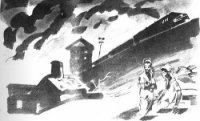Operation Nemesis: The Assassination Plot that Avenged the Armenian Genocide - Bogosian Eric (мир книг .txt) 📗
Concurrent with this plan, another scheme was beginning to take shape. If he could not find his mother or his family, Tehlirian would find revenge. He wasn’t sure what he was going to do exactly, but if it was something consequential, perhaps he could gain some sort of peace. Perhaps he could move on with his life.
Tehlirian said good-bye to Anahid and the Tatigian family in the port of Novorossiysk on the Black Sea and headed for Odessa, where he caught a passenger ship to Constantinople. As the steamer Euphrates churned down the Bosphorus and entered the harbor of the imperial city, the great mosques came into view. Tehlirian was twenty-two years old and only weeks away from his first kill.
CHAPTER FIVE The Debt
“War crimes” are defined by the winners. I’m a winner. So I can make my own definition.
—Adi Zulkadry, Indonesian executioner in the documentary film The Act of Killing
Soghomon Tehlirian arrived in Constantinople a twenty-two-year-old burnout on December 15, 1918, having spent the previous four years camping on the bare ground of deserted villages, rescuing refugee orphans, and burying mutilated corpses. He had covered thousands of miles, crossed many borders, survived a war zone, and wandered the ruined streets of his hometown. In the heat of battle, and while trudging across frozen wastes, he had watched as friends and strangers died. Now, although the fighting was over and an armistice had been declared, Tehlirian could not wake from the nightmare. He was lost in a haunted landscape of grief and pain.
In a state of shock, he wandered along the quays and crossed the teeming plazas, through the Grand Bazaar and past the hammams, the centuries-old bathhouses. He gazed up at historic facades he had only read about in books. Here was Constantine’s venerable Saint Sophia Cathedral, there the imposing gates of Topkapi Palace, where sultans had lived during the heyday of the empire. The famous Blue Mosque. The Hippodrome. He heard the muezzin’s call to prayer from the minaret of the awesome Suleymaniye Mosque, built on the orders of Suleiman the Magnificent four centuries earlier. Following the throngs, Tehlirian descended back down to the wharves and crossed the new Galata Bridge, where fishermen stood shoulder to shoulder. He climbed the hill past the medieval Genoese tower and entered the European neighborhood of Pera, where foreign soldiers mingled with desperate refugees. The British and the French recruits sauntered through the streets, all but oblivious to the hurly-burly surrounding them. It struck Tehlirian that the foreigners seemed amused by the neediness of the populace everywhere on display. Tehlirian cautiously stepped past decommissioned Ottoman soldiers in tattered uniforms lying on benches or crouched in doorways. These had been his enemy; now they slept in the parks or sold lemons outside the bazaar, destitute yet happy to have survived hell on earth. Tehlirian cursed them under his breath. These were the dogs who had killed his fellow Armenians, killed his friends and family. The young soldier had entered the belly of the beast.
Tehlirian had come to Constantinople to discover the fate of his missing mother and sisters-in-law. Fearing that they were dead, he needed to believe there was a possibility, no matter how slim, that they had survived. Perhaps they had been moved to some distant refugee camp or had emigrated to Greece or to France. There was little chance that they had returned to Erzincan, because going home was a dangerous option for any Armenian. Though armistice had been declared and British and French troops had secured Constantinople, eastern Anatolia was caught up in an anarchic civil war as nationalist troops, loyal to the CUP’s Ittihad regime, skirmished with Armenians and Greeks in the countryside.
Months earlier, in the fall of 1918, the Great War between Germany and the nations of the Triple Entente had officially ended. In anticipation of the arrival of British and French occupying forces, Talat and most of the top CUP officials had resigned on October 8. On November 1, with the “approval” of German diplomats, the key Central Committee members of the CUP had boarded a German torpedo boat, the Lorelei, and slipped out of town. With Talat were the remaining two thirds of the triumvirate, Djemal Pasha and Enver Pasha, as well as Dr. Bahaeddin Shakir, Dr. Mehmet Nazim, former Trebizond governor Djemal Azmi, and the notorious Bedri Bey, police chief of Constantinople. The Lorelei had steamed up the Bosphorus to the Russian port of Sevastopol in the Crimea. Safely beyond the reach of the British and French occupiers, the fugitives split up. Some headed for Berlin, others to Moscow or Rome.1
Lacking a legal government, the empire drifted like a ghost ship. The pro-British Sultan Mehmed VI, who had inherited the figurehead position from his half brother Mehmed V, who in turn had picked up the reins of power after Abdul Hamid abdicated in 1909, held no real power and so ingratiated himself with his British and French overseers. Sultan Mehmed hoped for reasonable terms for the last days of the Ottoman Empire as treaties of surrender were hammered out. And perhaps he could also hold on to some small piece of the sultanic treasure. Everyone could see that the empire was finished. The “sick man” was on life support.
With the dreaded Ittihadist leaders gone, the Greek patriarch took it upon himself to step into the power vacuum and enthusiastically declared independence for Greek subjects living in Constantinople, granting them independence from Ottoman law. Blue-and-white flags hung from windows throughout the Greek quarter. The Greek Christians of Turkey, subjects of the sultan for centuries, aspired to more than freedom from Muslim oppression. They dreamt of a “Great Idea” (Megali Idea), in which the neighboring country of Greece would invade and occupy the Turkish-Aegean coastal regions surrounding Smyrna, a territory historically populated with a majority of Turkish-speaking Christians who traced their lineage back to the Byzantines. Britain’s prime minister, David Lloyd George (a great friend of Greece’s King Alexander, who would famously die in 1920 from an infected monkey bite), supported a Greek troop invasion of the Turkish mainland. France did its part by training Armenian volunteers to bolster this post-armistice military occupation. Italy, too, wanted its piece of the pie and sent troops. Britain, having already occupied Mesopotamia (Iraq), was happy with the status quo. The British had also secretly agreed with France to share the conquered Arab lands. With the secret Sykes-Picot accord of 1916, France would gain control of Syria and the Levant.
Constantinople itself was divided into zones governed by the British, Italian, French, and Greek contingents. Non-Muslim high commissioners enjoyed powers that superseded even those of the sultan. The Allies had left thousands of dead behind on the beaches and bluffs of Gallipoli and suffered a grotesque defeat in the desert city of Kut. They memorialized their thousands of fallen brethren by stomping on Ottoman pride.
Marshal Louis Franchet d’Esperey of France entered the capital city riding a white horse, a symbolic gesture of victory harking back to the Crusades. Greeted by cheering crowds of Armenians and Greeks, d’Esperey occupied Enver Pasha’s mansion at Kuru Chesme. An armada of hundreds of British, French, and Italian ships lay anchored in the Bosphorus and the Sea of Marmara. The streets of Constantinople were crowded with thousands of foreign troops, Muslim refugees from Christian lands, Turkish refugees from Arab lands, Armenians, even Russians escaping their civil war. There was no room for optimism; the good old days, if they had ever existed, were surely gone forever. “The only Turks who prospered were black marketers and criminals.”2




